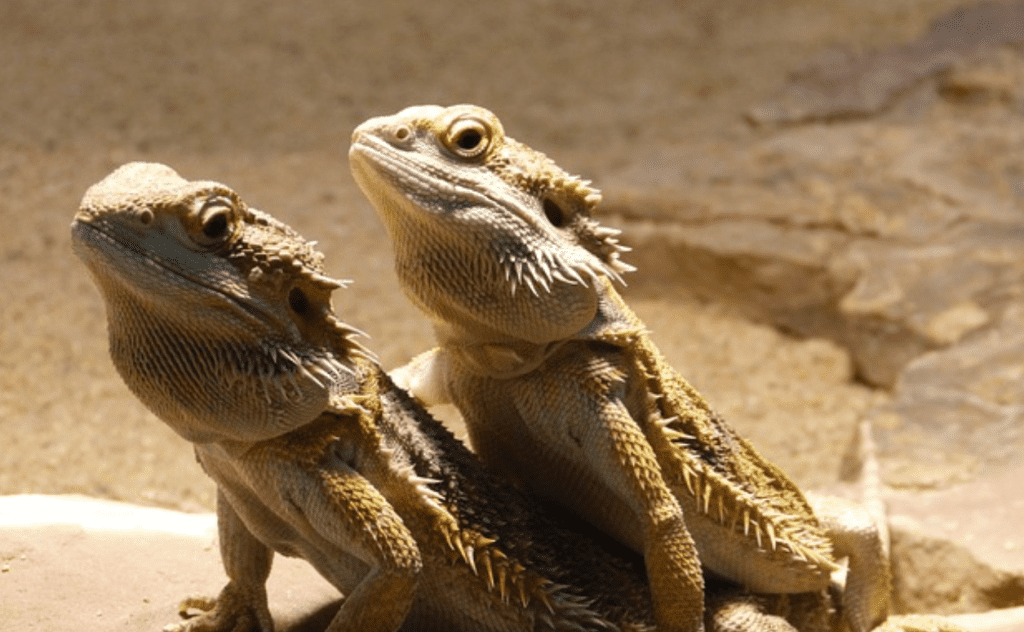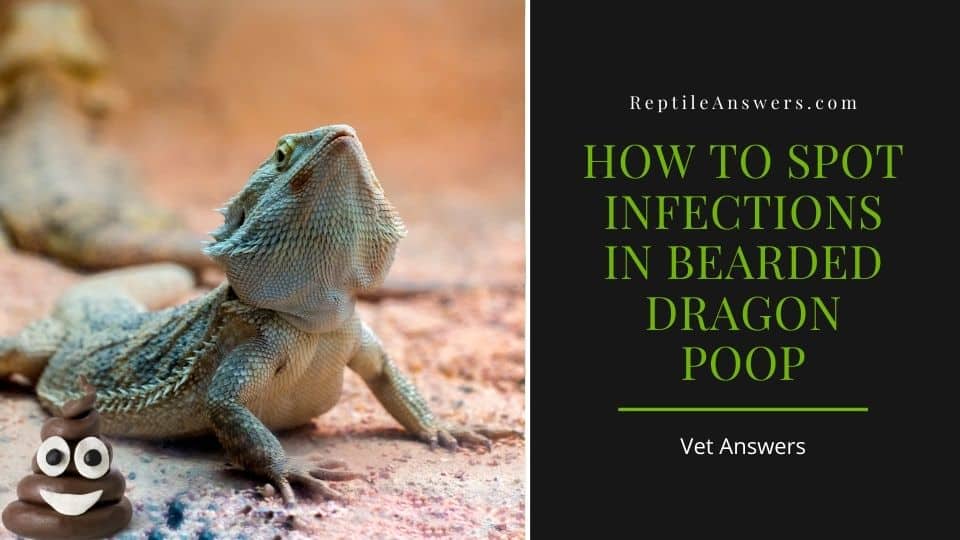Bearded dragons are popular pets, but they can be susceptible to infections. In this blog post, we’ll show you how to spot infections in bearded dragon poop and what you can do to treat and prevent them.

The Different Types of Bearded Dragon Poop and What They Mean.
Normal Bearded Dragon Poop
Bearded dragons typically poop once daily, and their poop should be well-formed and brown in color. If your bearded dragon’s poop is normal, it means that their digestive system is functioning properly.
Diarrhea
Diarrhea can be caused by several things, including a change in diet, stress, or an infection. If your bearded dragon has diarrhea, it is important to take them to the vet as soon as possible as it can lead to dehydration and other health problems.
Blood in the Stool
Blood in the stool can be a sign of an infection or other health problem. If you see blood in your bearded dragon’s stool, take them to the vet as soon as possible for treatment.
Worms in the Stool
Worms in the stool are also a sign of an infection and should be treated by a vet as soon as possible.
Green Poop
There are many possible explanations for green stool in a bearded dragon. It could be a sign of a dietary issue, such as eating too many green vegetables. It could also be a sign of a digestive issue, such as a bacterial infection.

Causes of Infections in Bearded Dragons.
Diet
A bearded dragon’s diet can play a role in causing infections. If a bearded dragon isn’t getting enough vitamins and minerals, their immune system can be weakened, making them more susceptible to infection. A lack of fiber in the diet can also lead to constipation, which can be a source of infection.
Environment
The environment can also play a role in causing infections in bearded dragons. If the enclosure is too small, it can lead to stress, which weakens the immune system and makes the beardie more susceptible to infection. A dirty enclosure can also harbor bacteria and parasites that can cause infection.
Stress
Stress is a common factor in causing infections in bearded dragons. Stress weakens the immune system, making beardies more susceptible to infection. Common causes of stress include: too small of an enclosure, inadequate diet, dirty enclosure, lack of hiding places, and handling by humans.

Signs of an Infection in Your Bearded Dragon.
Change in Appetite
One of the first signs that your bearded dragon may have an infection is a change in appetite. If your dragon suddenly stops eating or starts eating less than usual, it could signify something is wrong.
Weight Loss
Weight loss is another common sign of an infection in bearded dragons. If you notice that your dragon is losing weight, even if its appetite hasn’t changed, it’s essential to take them to the vet for a checkup.
Lethargy
Lethargy, or a lack of energy, can also indicate an infection in bearded dragons. If your dragon seems tired all the time and doesn’t want to move around much, it’s worth taking them to the vet for a checkup.
Change in Stool
A change in stool is another possible sign of an infection in bearded dragons. If you notice that your dragon’s poop is watery, bloody, or has worms in it, it’s important to take them to the vet right away, as these can all be signs of serious infections.
Blood in the Stool
Blood in the stool is one of the most serious signs of an infection and should always be taken seriously. If you see blood in your dragon’s stool, take them to the vet immediately as they may need antibiotics or other treatment to clear up the infection.

Treatment for Infections in Bearded Dragons.
Diet
The first step in treating an infection in a bearded dragon is to improve its diet. Bearded dragons are omnivorous, so they should have a diet that consists of both plants and animals. A good way to ensure that your bearded dragon is getting all the nutrients it needs is to feed it a variety of different foods.
Some examples of plants that can be included in a bearded dragon’s diet are kale, collard greens, turnip greens, and mustard greens. These greens are all high in vitamins and minerals, which will help boost your bearded dragon’s immune system.
As for animal protein, you can feed your bearded dragon live insects such as crickets and mealworms. You can also give them frozen-thawed insects, such as pinkie mice or earthworms. The important thing is to make sure that the animal protein is cooked thoroughly before feeding it to your bearded dragon. Raw meat can contain harmful bacteria that can make your reptile sick.
Environment
Another important factor in treating an infection in a bearded dragon is its environment. Bearded dragons are native to desert climates, so they need hot, dry conditions to stay healthy. If your beardie’s habitat is too wet or humid, this can create the perfect conditions for bacteria and other pathogens to thrive. This can lead to respiratory infections, skin infections, and other health problems.
To create the ideal environment for your bearded dragon, the temperature in the basking area should be between 95-100 degrees Fahrenheit (35-38 degrees Celsius), and the temperature of the rest of the enclosure should be between 75-85 degrees Fahrenheit (24-29 degrees Celsius). The enclosure should also have a UVB light to provide your bearded dragon with adequate vitamin D3 levels.
Stress
One of the most common causes of illness in reptiles is stress. Bearded dragons can experience stress from many different sources, including their diet, environment, and social interactions. When stressed, their immune system weakens, making them more susceptible to infection.
There are several things you can do to reduce stress in your bearded dragon:
- Make sure their enclosure is large enough, so they have plenty of room to move around.
- Provide hiding places, so they can retreat if they feel threatened.
- Handle them gently and avoid using loud noises or quick movements around them.
- Maintain a consistent routine with their feeding, watering, and cleaning schedule.
Antibiotics
If your bearded dragon has an infection that does not respond well to home treatment, you may need to give them antibiotics. Antibiotics are typically only given as a last resort because they can have side effects such as gastrointestinal upset and decreased appetite. They also kill both good and bad bacteria in the gut microbiome, which can lead to dysbiosis ( an imbalance of gut flora ).
Before giving your bearded dragon antibiotics, be sure to take them to see a veterinarian who specializes in reptiles. They can determine whether or not antibiotics are necessary and prescribe the correct dosage based on your pet’s weight.
Prevention of Infections in Bearded Dragons.
Bearded dragons are susceptible to various infections, so it is important to take steps to prevent them. The most common infections include respiratory, skin, and gastrointestinal infections. The best way to prevent infections is to maintain good hygiene and to keep your bearded dragon’s environment clean.
Be sure to clean their enclosure regularly and disinfect it with a safe reptile-friendly disinfectant. It is also important to handle your bearded dragon carefully, to avoid introducing bacteria or other contaminants to their skin.
Diet
Bearded dragons are omnivores, so their diet should consist of both plant and animal matter. A variety of fresh vegetables and fruits should be offered daily, along with a small amount of protein such as insects or meat. It is important to feed your bearded dragon food that is free from bacteria and parasites. Feed only live food to your bearded dragon, and avoid feeding them food that has been dead for more than 24 hours. If you are unsure about the safety of a food item, it is best to err on the side of caution and not feed it to your bearded dragon.
Stress
Stress is one of the leading causes of illness in bearded dragons. Bearded dragons can become stressed from a variety of sources, including changes in their environment, lack of food or water, handling by humans, and being housed with other animals. It is important to minimize stressors as much as possible to keep your bearded dragon healthy and happy.

Conclusion
As you can see, there are many different types of bearded dragon poop, and each one can mean something different. If you think your bearded dragon may have an infection, it’s important to watch for signs and get them treated right away. With the proper diet, environment, and stress management, you can help prevent infections in your bearded dragon.



